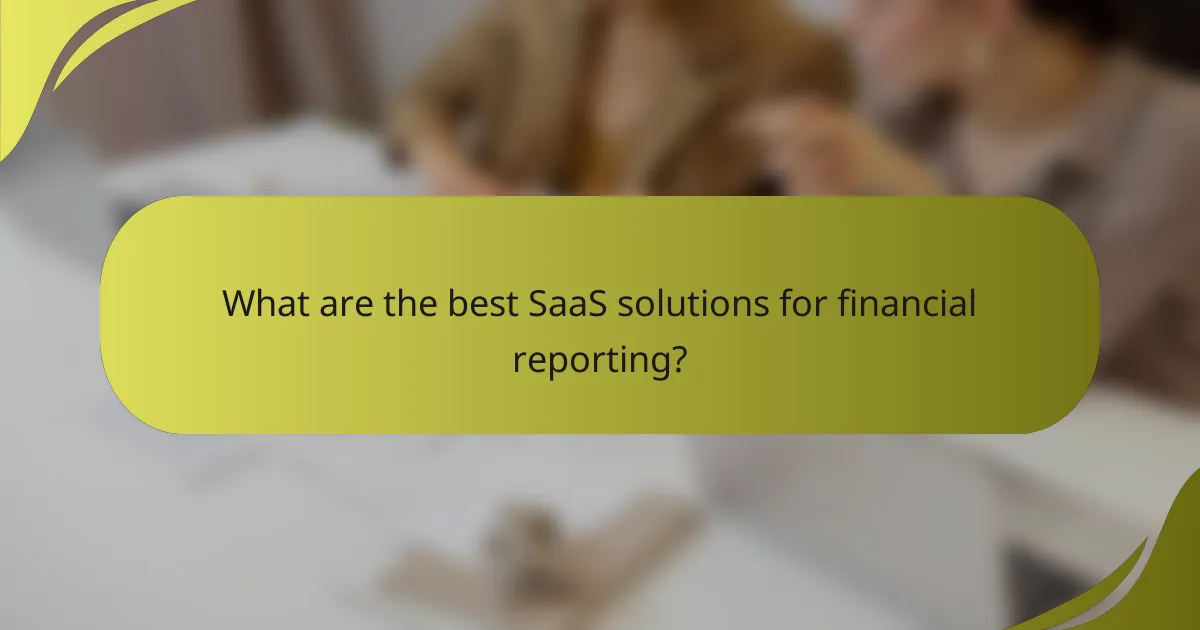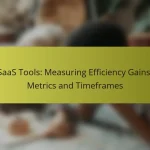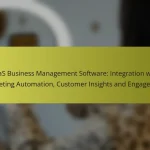In today’s fast-paced business environment, leveraging SaaS solutions for financial reporting is essential for ensuring accuracy, timeliness, and compliance. These platforms, such as QuickBooks Online and Xero, automate processes and provide real-time data access, significantly reducing human error and enhancing decision-making capabilities. By integrating seamlessly with banking systems, they help businesses maintain reliable financial data while adhering to regulatory requirements.

What are the best SaaS solutions for financial reporting?
The best SaaS solutions for financial reporting include platforms that enhance accuracy, ensure timely updates, and maintain compliance with regulations. Popular options like QuickBooks Online, Xero, NetSuite, FreshBooks, and Zoho Books cater to various business needs and sizes.
QuickBooks Online
QuickBooks Online is a widely used financial reporting tool that offers robust features for small to medium-sized businesses. It provides real-time financial data, customizable reports, and seamless integrations with various applications.
Users can easily track income, expenses, and generate financial statements such as profit and loss reports. QuickBooks Online also supports compliance with accounting standards, making it a reliable choice for businesses aiming for accuracy and timeliness.
Xero
Xero is a cloud-based accounting software known for its user-friendly interface and strong reporting capabilities. It allows businesses to automate invoicing, bank reconciliation, and expense tracking, which enhances efficiency in financial reporting.
With features like customizable dashboards and real-time collaboration, Xero helps teams stay aligned on financial performance. It is particularly favored by small businesses and freelancers looking for straightforward financial management solutions.
NetSuite
NetSuite is an enterprise resource planning (ERP) solution that includes comprehensive financial reporting features suitable for larger organizations. It integrates various business functions, providing a holistic view of financial health.
NetSuite supports advanced reporting and analytics, enabling businesses to create detailed financial forecasts and performance metrics. Its scalability makes it ideal for growing companies that require robust financial oversight and compliance with international standards.
FreshBooks
FreshBooks is designed primarily for service-based businesses, offering simple invoicing and expense tracking. Its financial reporting tools help users generate essential reports like profit and loss statements with ease.
FreshBooks emphasizes user experience, making it accessible for those without extensive accounting knowledge. It is particularly beneficial for freelancers and small business owners who need straightforward financial insights without complex features.
Zoho Books
Zoho Books is a comprehensive accounting software that provides strong financial reporting capabilities tailored for small to medium-sized enterprises. It automates various accounting tasks, including invoicing and tax calculations, which streamlines the reporting process.
With features like multi-currency support and compliance with local tax regulations, Zoho Books is an excellent choice for businesses operating in diverse markets. Its affordability and integration with other Zoho applications enhance its appeal for budget-conscious companies.

How do SaaS solutions ensure accuracy in financial reporting?
SaaS solutions enhance accuracy in financial reporting through automated processes, real-time data checks, and seamless integration with banking systems. These features minimize human error and ensure that financial data is both reliable and up-to-date.
Automated data entry
Automated data entry significantly reduces the risk of errors associated with manual input. By using optical character recognition (OCR) and machine learning algorithms, SaaS platforms can extract data from invoices and receipts, inputting it directly into financial systems. This process not only saves time but also enhances the accuracy of reported figures.
To maximize the benefits of automated data entry, ensure that your SaaS solution is compatible with various document formats and regularly updated to recognize new data patterns. Regular audits of the automated entries can help catch any discrepancies early.
Real-time data validation
Real-time data validation checks the accuracy of financial information as it is entered into the system. This feature alerts users to inconsistencies or errors immediately, allowing for quick corrections. For instance, if a user inputs a transaction that exceeds a predefined limit, the system can flag it for review.
Implementing robust validation rules tailored to your business needs can further enhance accuracy. Regularly reviewing these rules ensures they remain relevant and effective as your financial practices evolve.
Integration with bank feeds
Integration with bank feeds allows for automatic synchronization of financial transactions, ensuring that reported data reflects actual bank activity. This feature minimizes discrepancies between recorded transactions and bank statements, which is crucial for accurate financial reporting.
When setting up bank feed integrations, choose a SaaS solution that supports multiple banks and currencies, especially if your business operates internationally. Regularly monitor these integrations to ensure they function correctly and that all transactions are accounted for accurately.

What features enhance the timeliness of financial reporting?
Timeliness in financial reporting is significantly improved by features that facilitate immediate access to data and automate routine tasks. Key functionalities such as real-time dashboards, scheduled reporting, and alerts for deadlines ensure that financial information is available when needed, reducing delays and enhancing decision-making.
Real-time dashboards
Real-time dashboards provide instant visibility into financial metrics and key performance indicators (KPIs). These visual tools aggregate data from various sources, allowing users to monitor financial health at a glance. For example, a dashboard can display current cash flow, outstanding invoices, and budget variances in a single view.
When implementing real-time dashboards, consider integrating them with existing accounting software to ensure seamless data flow. This integration minimizes manual updates and enhances accuracy, leading to more timely insights.
Scheduled reporting
Scheduled reporting automates the generation and distribution of financial reports at predetermined intervals, such as weekly or monthly. This feature reduces the manual effort required to compile reports, ensuring that stakeholders receive consistent updates without delays. For instance, a company might schedule a monthly profit and loss statement to be sent automatically to management.
To maximize the benefits of scheduled reporting, set clear timelines and ensure that the reports are tailored to the needs of the audience. Regularly review the reporting schedule to adapt to changing business needs or regulatory requirements.
Alerts for deadlines
Alerts for deadlines help organizations stay on track with critical financial reporting timelines, such as tax filings or quarterly reviews. These notifications can be set up to remind users well in advance, allowing ample time to prepare necessary documents and data. For example, a reminder for an upcoming tax submission can prevent last-minute rushes and errors.
To effectively utilize alerts, customize them based on the specific needs of your organization and the regulatory environment. Ensure that the alerts are sent through reliable channels, such as email or mobile notifications, to guarantee timely awareness of impending deadlines.

How do SaaS solutions support compliance in financial reporting?
SaaS solutions enhance compliance in financial reporting by automating processes, ensuring accuracy, and facilitating adherence to regulations. These platforms provide real-time updates and tools that help organizations maintain compliance with evolving financial standards.
Regulatory updates
SaaS solutions automatically integrate regulatory updates, which is crucial for maintaining compliance in financial reporting. By leveraging cloud technology, these platforms can quickly adapt to changes in laws and standards, such as IFRS or GAAP, ensuring that financial reports are always aligned with current requirements.
Organizations using SaaS for financial reporting can benefit from automated alerts and notifications regarding regulatory changes. This proactive approach minimizes the risk of non-compliance and potential penalties, making it easier to stay informed and compliant.
Audit trails
Audit trails are essential for compliance, and SaaS solutions provide comprehensive tracking of all financial transactions. These trails document who accessed or modified data, when changes occurred, and what specific alterations were made, creating a transparent history that is vital for audits.
Having a robust audit trail helps organizations demonstrate compliance during regulatory reviews. It also aids in identifying discrepancies or errors, allowing for timely corrections before they escalate into larger issues.
Data security measures
Data security is a critical component of compliance in financial reporting, and SaaS solutions typically offer advanced security measures. These may include encryption, multi-factor authentication, and regular security audits to protect sensitive financial information from unauthorized access.
Organizations should ensure that their chosen SaaS provider complies with relevant data protection regulations, such as GDPR or CCPA, to safeguard customer data. Regularly reviewing and updating security protocols is essential to maintain compliance and protect against data breaches.

What criteria should you consider when selecting a financial reporting SaaS?
When selecting a financial reporting SaaS, consider factors such as scalability, integration capabilities, compliance with regulations, and user-friendliness. These criteria ensure that the solution meets your organization’s current needs while being adaptable for future growth.
Scalability
Scalability refers to a SaaS solution’s ability to handle increased workloads and user demands without compromising performance. A scalable financial reporting system can grow alongside your business, accommodating more transactions and users as needed.
When evaluating scalability, look for features such as flexible pricing models that adjust based on usage, and the ability to add new functionalities or modules easily. For instance, a solution that allows you to upgrade from basic reporting to advanced analytics as your needs evolve can save time and costs in the long run.
Common pitfalls include choosing a solution that may seem adequate for your current size but lacks the capacity for future expansion. Ensure that the provider has a proven track record of supporting businesses of various sizes and can provide case studies or testimonials to back their claims.


